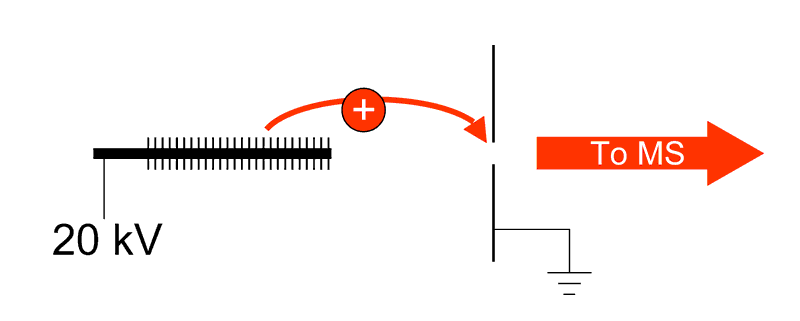Field desorption/field ionization (FI) refers to an
ion sourceAn ion source is an electro-magnetic device that is used to create charged particles. These are used primarily to form ions for mass spectrometers, optical emission spectrometers, particle accelerators, ion implanters and ion engines.- Electron ionization :...
for
mass spectrometryMass spectrometry is an analytical technique that measures the mass-to-charge ratio of charged particles.It is used for determining masses of particles, for determining the elemental composition of a sample or molecule, and for elucidating the chemical structures of molecules, such as peptides and...
first reported by Beckey in 1969. In field ionization, a high-potential electric field is applied to an
emitter with a sharp surface, such as a razor blade, or more commonly, a filament from which tiny "whiskers" have formed. This results in a very high electric field which can result in ionization of gaseous molecules of the analyte. Mass spectra produced by FI have little or no fragmentation. They are dominated by molecular radical cations M
+. and less often, protonated molecules

.
Mechanism
In FD, the analyte is applied as a thin film directly to the emitter, or small crystals of solid materials are placed onto the emitter. Slow heating of the emitter then begins, by passing a high current through the emitter, which is maintained at a high potential (e.g. 5 kilovolts). As heating of the emitter continues, low-vapor-pressure materials get desorbed and ionized by alkali metal cation attachment.
Applications
Many earlier applications of FD/FI to analysis of polar and nonvolatile analytes such as polymers and biological molecules have largely been supplanted by newer ionization techniques. However, FD/FI remains one of the only ionization techniques that can produce simple mass spectra with molecular information from hydrocarbons and other particular analytes. The most commonly encountered application of FD/FI at the present time is the analysis of complex mixtures of hydrocarbons such as that found in petroleum fractions.
Liquid injection
The recently developed liquid injection FD ionization (LIFDI) technique "presents a major breakthrough for FD-MS of reactive analytes" : Transition metal complexes are neutral and due to their reactivity, do not undergo protonation or ion attachment. They benefit from both: the
soft FD ionization and the safe and simple LIFDI transfer of air/moisture sensitive analyte solution. This transfer occurs from the Schlenk flask to the FD emitter in the ion source through a fused silica capillary without breaking the vacuum.
The source of this article is
wikipedia, the free encyclopedia. The text of this article is licensed under the
GFDL.


 .
.
